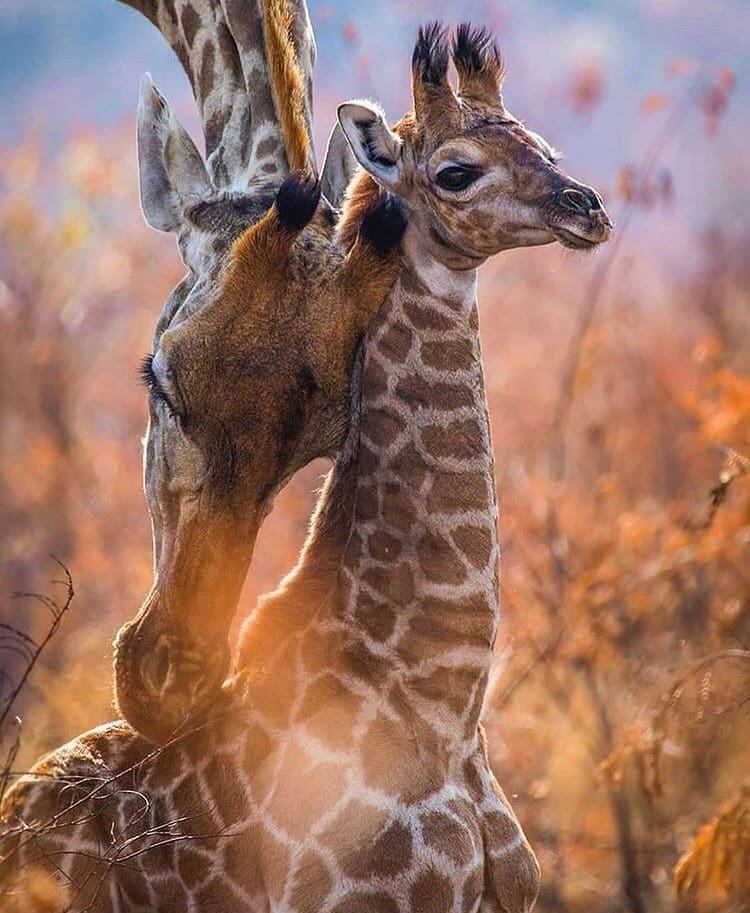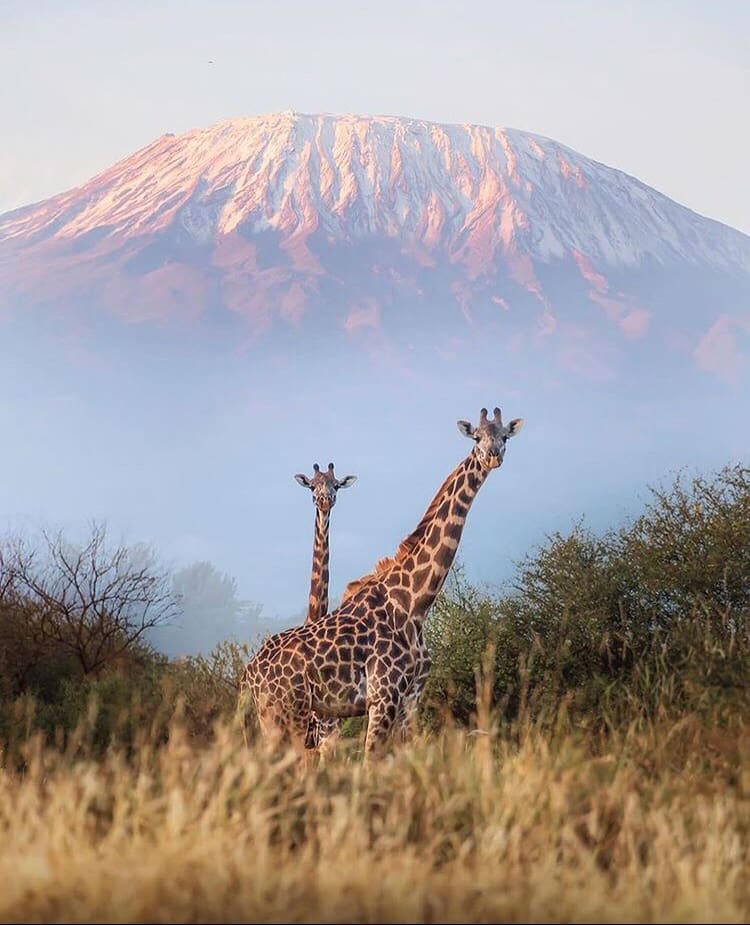[social_warfare]
One of the most iconic animals in the world, the giraffe is loved by many the world over. And for good reason.
They are equal parts beautiful as they are comical looking. This has led to them becoming one of the most marketable animals on earth.
What is the Giraffe?
The giraffe is the tallest animal on earth and one of the largest on the African plains.
There are nine subspecies found across sub-Saharan Africa, all of which are admired for their size and beauty.

Appearance
What does the giraffe look like?
Giraffes are lanky and slender. Their gait is a pace, which means legs on the same side move together.
All the subspecies’ boast purple-blue tongues, stubby horn-like protrusions on their heads and of course, outrageously long necks.
Each subspecies boasts a slightly varied pattern, perfectly designed to blend in with their habitat. What they all have in common is a beautiful spotted coat, with a pattern unique to each individual – just like human fingerprints. Coat patterns are even used to identify specific individuals during wildlife studies.

They have very pronounced lips and no teeth on the front, upper jaw. Instead they have a hardened dental pad that allows them greater control while pulling leaves from tree branches. They also have incredibly long tongues. These are purple-blue in colour and grow to an impressive half a meter long!
Both genders have what appear to be horns atop their heads. These are actually nothing more than cartilage protrusions, covered with skin and hair.
Their main purpose is to protect the head from injury. These ‘horns’ are more pronounced in males as they’re used in territorial fights. They also tend to be bald on top – an easy way to distinguish between genders. Yet another similarity with humans!

How tall is the giraffe?
Giraffes vary in size according to geographic location. In east Africa, adult males can grow to more than 18 feet (5.5 meters) tall, while females usually max out at about 14 feet (4.5 meters). Southern African subspecies are usually slightly smaller. A giraffe will reach its maximum height at just 4 years old.
Mature bulls are very heavy and can weight over two tonnes, while females tend to max out at just over one ton. Despite reaching full height at fours years old, they continue to fill out, and will grow until around seven years old.

How long is a giraffes neck?
The giraffe’s most distinguishing feature is its unusually long neck. In fully grown adults, the neck can contribute to more than 7ft. (2 meters) of the animal’s overall height.
In order to be able to drink without losing consciousness, the giraffe’s neck contains special veins and valves that regulate the flow of blood to its head.
Male giraffes use their necks to fight one another, and those with the longer neck generally have an advantage. It is thought that females also find longer necks more attractive.
Behaviour
What does the giraffe eat?
Giraffes are some of the most picky eaters in the bush. Despite feeding for between 16 and 20 hours per day, these giant herbivores will generally only eat around 66lbs. (30 kilograms) of food during that time. They can even survive on as little as 15lbs. (7kg) of food per day.
Their incredible height allows them to feed on leaves not accessible to any other species. Acacia trees have been found to be the giraffe’s preferred food source, despite evidence suggesting these browsers may feed on more than 90 varieties of foliage.
A giraffe will always drink when water is available, but don’t need large amounts of water to survive. This means they can survive in very arid and harsh environments.
Interestingly, a giraffe’s neck is actually too short to reach the ground due to the animal’s incredibly long legs. In addition to this, the giraffe also can’t lean forward or bend its front legs. In order to get low enough to drink, giraffes have to spread their legs wide apart to allow for them to sufficiently lower themselves to the water.
How fast are giraffes?
Despite their placid demeanour and gangly appearance, giraffes are actually very fast!
They can reach speeds of up to 100 miles and hour (60km/h) at full. Although they only ever run this fast when trying to escape a hunting pride of lions.
Giraffe social structure
Giraffes live in herds of between five and twenty individuals on average, although huge herds of up to fifty can be observed at times.
They are a social species, but don’t form strong family bonds like other species. This is usually only seen in mothers with young calves, and it’s not uncommon for herd members to move off and join another herd.
Calves are born at 7ft. (2 meters) tall and are able to walk alongside their mother within a few hours. Youngsters will stay with their mothers for 18-24 months before becoming independent.
Males tend to leave the herd and form bachelor groups, while its more common for females to stick with the herd.
They are non-territorial, but will usually stick to a home range. This can be as small as 95 square kilometres in wet regions, or as large as 1,500 square kilometres in dry regions.
Giraffes have one of the lowest sleep requirements in the animal kingdom, only sleeping for around four hours a day.
They will either sleep standing up, or sitting down, and actual sleep occurs in short spurts of a few minutes at a time.
Habitat & Range
Where do giraffes live?
Giraffes are highly adaptable and can live in a variety of habitats, provided there are trees. Generally they’re found in woodlands, savannas, forests and desert landscapes.
They are plentiful across sub-Saharan Africa, with particular strongholds in southern and east Africa. There are 9 different subspecies that occur across this region, most of which are native to a specific area. For example, the reticulated giraffe is unique to Samburu National Park in Kenya.
Which countries do giraffes live in?
Giraffes can be found living in: Angola, Botswana, Cameroon, Central African Republic, Chad, DR Congo, Ethiopia, Kenya, Mali, Mozambique, Namibia, Niger, Rwanda, Somalia, South Africa, South Sudan, Swaziland, Tanzania, Uganda, Zambia, Zimbabwe.
Conservation
How many giraffe are there in the wild?
Estimates suggest there are between 120,000 and 150,000 giraffe living in the wild in Africa at present.
Is the giraffe endangered in Africa?
The giraffe is currently listed as ‘Vulnerable’ on the IUCN red list which means they are at risk of becoming endangered.
Threats to the giraffe in the wild
Although few predators attack adult giraffes, lions, hyenas, and leopards take their toll on the young. Scientists report that only one-quarter of infants survive to adulthood due to the high rates of predation.
Safari
The best places to see giraffe in the wild
Giraffe are common, and found in all of Africa’s large national parks and game reserves. Because of their adaptability and demeanour, they are also common on small farms and private collections.
Here are some of the best places to see giraffe in Africa:
- Murchison Falls National Park, Uganda
- Samburu National Reserve, Kenya
- Kruger National Park, South Africa
- Etosha National Park, Namibia
- Chobe National Park, Botswana
Tips for spotting Giraffe in the wild
Although very well camouflaged, they are usually not hard to see thanks to their towering size.
- Drive slowly – If you’re self-driving through one of the national parks in Africa, its very important to maintain a slow speed. Both for the safety of the animals, but also because animals are designed for camouflage and can be very easily missed, even in thin foliage.
- Find trees – Giraffes have long necks for a reason, and spend the entire day feeding. You’re not likely to seem them wandering along an open plain, so stick to wooded or forest areas with an abundance of trees.
- Go on a guided safari – Commercial safari lodges usually operate guided game drives with a skilled field guides who understand the movement of animals. They are expertly trained at spotting animals in the wild and will almost definitely be able to find a herd of giraffe.
- Be respectful – Giraffes are quite skittish and will flee at any sign on danger. Keep a safe distance and approach with caution so to not stress the animals you’re viewing. Please always allow a safe distance and treat wild animals with respect.
Facts about the giraffe
- Sleep – Giraffe’s don’t need much sleep and usually spend less than 4 hours sleeping per day.
- Heart size – A giraffe’s heart grows to around 2 ft. (60cm) long and weighs around 25lbs (11kg).
Myths about the giraffe
- Multiple hearts – Despite their size, giraffes don’t have multiple hearts as is commonly believed. They only have one, rather large heart!







